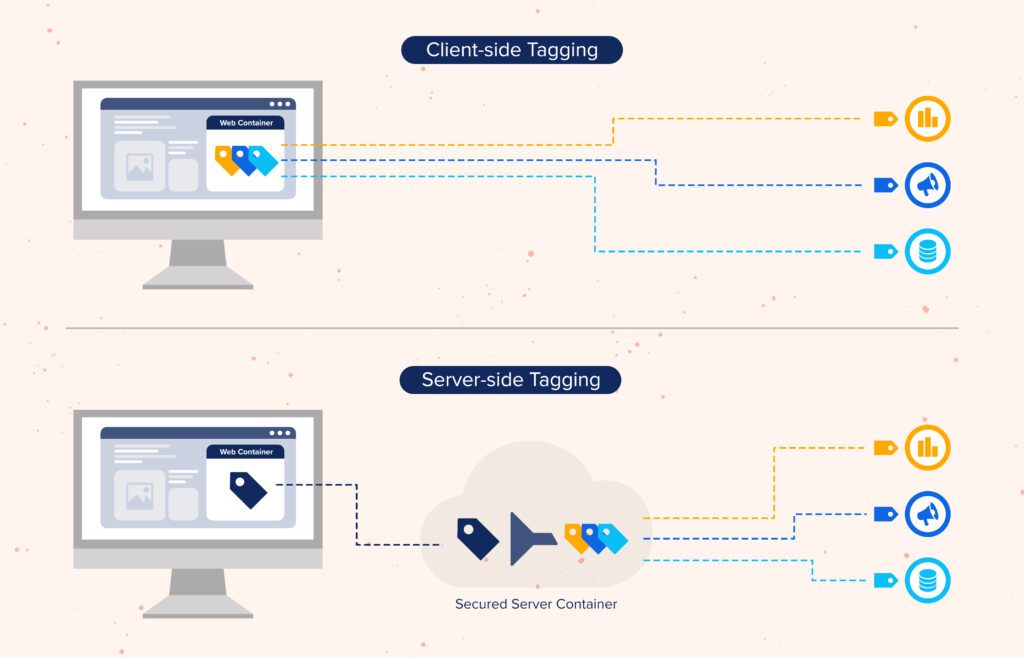Server-side tracking is an approach to data collection that has been gaining popularity in recent years for a variety of reasons. There are many benefits to moving to server-side tracking, but there are also trade-offs that come with the move. In this blog post, we provide an overview of server-side tracking, lay out the key benefits and the trade-offs to consider, and make some predictions about the future of digital data collection.
What is server-side tracking, and how is it different from client-side tracking?
Server-side tracking (SST) is an approach to tracking user behavior on a website or application, where data is collected and processed on the server side before being routed to an endpoint — as opposed to being directly sent to an endpoint from the client side. For example, with SST, data is first collected by a server you control before being sent to analytics platforms like Google Analytics or Adobe Analytics.

Client-side tracking, by contrast, involves the use of scripts or tags that run on the client-side — typically within the user’s browser. These scripts and tags can be embedded directly within a webpage, or run via a tag management system such as Google Tag Manager. Either way, as these scripts and tags collect data, they send it directly from the client to the respective endpoint.
As such, the primary difference between these two approaches is the location where data is collected before being sent to an analytics platform. This might not seem like an important difference, but in reality, the choice of collecting data server-side or client-side leads to a variety of implications that organizations should carefully consider.
What are the benefits of server-side tracking?
SST opens up a variety of benefits relative to client-side tracking. We’ll briefly touch on some of the most common benefits in this post.
- Control & Governance: With SST, you have far greater control over data collection than you do when tracking occurs client-side. When you deploy client-side tags and scripts, third parties have “direct access” to data being generated on your website, mobile app, etc. With SST, however, you have the ability to gather data in a centralized, first-party context before sending data to third parties as you see fit. For example, you can edit, redact, or otherwise exert governance over data before it ever reaches a third-party analytics platform. This makes organizations much better equipped to manage their analytics deployments in compliance with the ever-changing regulatory environment (think GDPR, CCPA, and the many regulations coming into effect all over the world).
- Improved Data Accuracy & Completeness: SST should produce more accurate and more complete datasets than client-side tracking, which is prone to various issues that don’t affect SST. For example, SST can successfully capture user interactions with a website, even when JavaScript is disabled within the user’s browser. More importantly, client-side tracking is, with increasing frequency, blocked by browsers (such as Brave) and browser extensions that users adopt for privacy reasons. SST, by contrast, allows you to constrain data collection strictly to the first-party context, and as a result isn’t nearly as impacted by blockers.
- Improved User Experience: Collecting data server-side rather than client-side can make a meaningful difference in terms of user experience. Why would the choice of tracking methodology impact UX? When you move to SST, you’re potentially making a dramatic reduction in the amount of JavaScript required to execute on the client side. This means that users experience less latency (i.e. pages load more quickly), which leads to improvement engagement, higher conversion rates, etc.
In summary, server-side tracking can give you better control over your data, can drive improvements in data accuracy and completeness, and can even directly contribute to an improved user experience. Given all of these benefits, why doesn’t everyone leverage SST as the standard? Let’s explore some of the trade-offs that come with SST.
What are the trade-offs that come with moving to server-side tracking?
There are reasons why client-side tracking has been the standard for years, and continues to be by far the most common approach today. Here are a few points to consider as you weigh the relative benefits of server-side and client-side tracking.
- Ease of use: With the advent of tools like tag management systems, client-side tracking has become very easy — some would say too easy. Even non-technical stakeholders can log into a system like Google Tag Manager and add new analytics tags, conversion tags, and so on. This helps organizations stay nimble, but also contributes indirectly to issues like tag bloat. Server-side tagging, on the other hand, requires organizations to configure servers, manage and maintain them over time, and so on.
- Cost: Adopting SST means investing in some infrastructure that isn’t necessary when you rely on client-side tracking. For example, because you’re no longer piping data directly to a third-party endpoint, you’ll need a place to store this data — and you’ll need to pay for that storage.
- Read/Set Third-Party Cookies: Yes, third-party cookies are not long for this world. But in the immediate term, many organizations continue to utilize and depend on these cookies. When you move to SST, you’ll no longer have the ability to set, or to read from, third-party cookies. This has a direct impact on your ability to, for example, retarget audiences across ad networks based on on-site behaviors.
How are analytics deployments likely to change in the future?
By now, you’ve seen that while SST opens up a variety of important benefits, it also leads to some trade-offs that organizations may not want to make — especially not without careful consideration. In general, though, we expect SST to become more popular over time. As the regulatory environment surrounding data and analytics continues to become more stringent, governance and compliance capabilities will become more important than ever — and this will shift the cost/benefit analysis increasingly in favor of SST. If you want to learn more about SST, look out for a series of more detailed posts that we’ll be publishing soon to more fully explore the benefits, the costs, and options organizations have when considering SST.
Author

Nick is Vice President of Analytics at Cardinal Path, where he is
View all posts
responsible for the commercialization and delivery of Google Analytics and related services. When not working with clients, Nick authors original research, articles and blog posts, and speaks at conferences around the world. He is an alumnus of the 2023 college football national champion University of Michigan.














